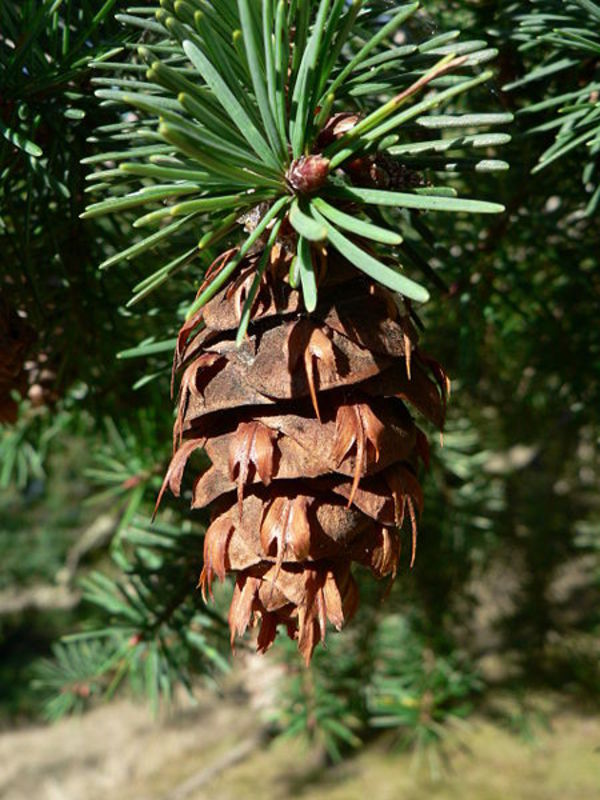
Common Name: Douglas Fir | Scientific Name: Pseudotsuga Menziesii

Family Name: Pinaceae
Introduction
This pine produces one of the most lovely teas in the world. Its stunningly delicious and packs a health building punch as well. It stimulates the body to eliminate toxins and, more! Find this tea!
Resources
Chapter from …
Chapter from …
Douglas Fir (Pseuudotsuga menziesii) —— Pine-tastic!
This is the only word that describes Douglas Fir tips, my new favorite herbal medicine. And, this love affair started innocently enough. I came home one day to find a box of Douglas Fir tips had arrived in the post. The package was radiating a scent so intoxicating, I had to rip it open to get a better smell. Once in my hot little hands, I spent the remains of the day picking up the sachet and smelling it. Like a cat with his nip, I could not leave it alone. The rest is history.
And, its seems, I am not the first person seduced by Douglas Fir tips. Pioneers and gold rush folks alike encountered the tree on their westward journeys to California, Oregon, and Washington. Once acquainted. they too came under its spell. In fact, its named for the Scottish botanist David Douglas who spotted it on an 1825 trip to the wild, Wild West. So dazzled by its fragrance, Douglas dragged the plant all the way back to the British Isles so as never to be without it.
Though the settlers fell for it, the tree was first adored by the Native Americans. They loved this tree so much it was well woven into local legend. According to the Tewa tribe, mankind climbed down to earth by climbing down the Douglas Fir. And, when it was time to go back to heaven, the did so by following the heavenly scent back home. (1)
Native people who lived in its midst used it for a host of purposes. Those that didn’t have access to it, traded corn to secure a supply. Herbal clue. Tradable equals valuable! (1)
Its uses by Native Americans were many. Its branches were used to decorate dancers in a variety of rituals dances(1) and to activate sweat lodges and purifying rituals. A resin collected from its trunk was used to heal cuts, burns, wounds, sprains, injured bones, sore throats, coughs, and was used as a famine food. The green bark was used to improve digestive problems. An infusion of the fresh twigs was used as application for arthritic joints and paralysis, kidney and bladder problems, and venereal disease. (2)
Contemporary research has begun to unravel the mystery of this trees beguiling scent. It contains an odd collection of over 20 different votalile oils, including Citronellol, Limonene, Pinene, Sabinene, that work together to create its overall fragrance. The odd part is that tips are extremely rich in oils usually found in citrus trees. The presence of these oils explains the lemony edge of Douglas Fir. (3)
Using it!!!
Douglas Fir tip tea makes an excellent cleansing beverage. It stimulates the organs of excretion which in turn rid of the body of toxins. In fact, bears collect the tips and use them cleanse themselves after their winters’ hibernation. I suggest you follow their lead.
In fact, think about treating yourself to a Douglas Fir spring clean. Get a supply of Douglas Fir tea bags and a Douglas Fir Tree sachet. Sit down to a cup of this tasty lemony tea and smell the sachet while you are drinking your tea. I can assure, you will feel like you are climbing your way to heaven.
Here’s another suggestion. Use your Douglas Fir tip sachet to turn a bad mood around. Keep the sachet in your purse, back pack, or brief case. When you feel your mood traveling south, pull out the sachet and breath deeply. In moments, your mood will begin to ascend.
Douglas Fir Sachet($) and Douglas Fir Spring Tip Tea(15 tea bags for $7.95) are available from Juniper Ridge, Western Wild Foods. 1-800-205-9499 or www.JuniperRidge.com .
Constituents and Actions
Alpha-Pinene(10.4%): Allelochemic, anti-inflammatory, cancer preventative, coleoptiphile, insectifuge,
Alpha-terpinene: insecticide
Alpha-terpinolene:
Beta Pinene 27.85%: insecticide
Beta-cimene
Beta-caryophyllene .17%
Beta-ocimene
Borneol .10%
Analgesic, antiinflammatory, febrifuge, hepatoprotectant, spasmolytic.
Camphene .60%
Citronellyl acetate:
Citronellol 1%
Bacteriacide, fungicide, candidacide, sedative.
Delta-3-carene: anti-inflammatory, bactericide, insectifuge,
Delta-3-Darene 12.85%
Gammaterpinene 3.5%: insectafuge
Geranyl acetate 1.15%
Germacrene .4%
Limonene 3.45%: Ach inhibitor, anti-cancer, anti-lithic, bactericide, cancer preventatitive, hypcholesterolemic, insecticide, insectifuge, litholytic.
Pinene: Antiseptic, bactericide, expectorant, fungicide.
Sabinene 12.85%
Terpinolene 11.5%
Terpinene-4-ol 4.85%
Anti-allergic, antiasthmatic, antiseptic, antitussive, bacteriostatic, fungicide,
Other Constituents
Chlorogenic acid(choleretic)
References
1. Robbins, Wilfred, Harrington, John, and Freire-Marreco, Barbara. Ethnobotany of the Tewa Indians. Bureau of American Ethnology. 1916. Page 43-44
2. White Lotus Aromatics Newsletters. Douglas Fir Newsletter. #24 July 25, 2001.
3. Duke, James. Handbook of Biologically active Phytochemicals and their activities. CRC. 1992.
Disclaimer: The author makes no guarantees as to the the curative effect of any herb or tonic on this website, and no visitor should attempt to use any of the information herein provided as treatment for any illness, weakness, or disease without first consulting a physician or health care provider. Pregnant women should always consult first with a health care professional before taking any treatment.
